Survey on Developing a Low Cost System for Taxi Payment
by Suleiman Taha, Raed Saeed Mohammad Daraghma* ![]()
Department of Communication Engineering and Technology, Palestine Technical University Kadoorie, Tulkarm, 62451, Palestine
* Author to whom correspondence should be addressed.
Journal of Engineering Research and Sciences, Volume 1, Issue 5, Page # 154-159, 2022; DOI: 10.55708/js0105016
Keywords: RFID, Smart Credit Card, Arduino MEGA
Received: 24 February 2022, Revised: 05 April 2022, Accepted: 11 May 2022, Published Online: 25 May 2022
APA Style
Taha, S., & Daraghma, R. S. M. (2022). Survey on Developing a Low Cost System for Taxi Payment. Journal of Engineering Research and Sciences, 1(5), 154–159. https://doi.org/10.55708/js0105016
Chicago/Turabian Style
Taha, Suleiman, and Raed Saeed Mohammad Daraghma. “Survey on Developing a Low Cost System for Taxi Payment.” Journal of Engineering Research and Sciences 1, no. 5 (May 1, 2022): 154–59. https://doi.org/10.55708/js0105016.
IEEE Style
S. Taha and R. S. M. Daraghma, “Survey on Developing a Low Cost System for Taxi Payment,” Journal of Engineering Research and Sciences, vol. 1, no. 5, pp. 154–159, May 2022, doi: 10.55708/js0105016.
In this post, we built a small gadget that can be placed in the front of the cockpit, closer to the driver, and can be accessed by both the taxi driver and the passenger. It is simple to operate since it has a crystal display that displays a wealth of information about both the section cut and the distance’s eventual cost. The piece, which is also the delivery charge, as well as the passenger card’s identification card and other explanatory information, and the system, is equipped with a simple and secure payment method that is based on radio wave technology and is linked to the company database. The payment service and the taxi driver are both connected to the internet via a wireless transmission device, and the person who has the card is stored in a specific financial bank’s database. Because the payment manner is easy, the primary goal of this instrument’s design is to prevent passenger money from being stolen, as well as for the driver, and it is a more pleasant, softer, faster, and safe method to handle.
1. Introduction
Given the incredible technological advancements of the twenty-first century, as well as the significant acceleration in the trend toward integrated systems and their development in a way that allows users to complete several everyday tasks with minimal time and effort. We must keep up with the wheel of technological progress in the current period, particularly in the domain of easy-to-use automated systems and their advantages in integrity and rapidity in performing sophisticated procedures, as well as their high abilities and linking to one another through global Wireless Sensor Networks (WSNs) and the ability to enter and link with the World Wide Web. According to literature reviews, there are electronic payment gadgets that rely on people’s IDs to simplify their payment procedures. Some taxi firms and organizations have resorted to electronic payment systems as a term for current and future advancement and orientation in this area, as well as their reliance on electronic payment cards. In paper [1], the author devised a way for paying a cab electronically with a traveler’s card, so reducing the need to carry cash. Furthermore, he proposed and implemented such a system by repairing one or more card readers into the taxi and utilizing an individual taximeter with new characteristics. The Smart Credit Card (SCC) was used to make the payment, which was deducted from the customer’s account. The information from proposed services was saved in the system and will be displayed as services. In paper [2], the author researched the current industry case, procedure structure, and styles of micropayment services in Taiwan local and international taxi services, as well as the methods that simplified success, in order to make the findings helpful, theory-based references for developers of the taxi industry’s micropayment system. According to his results, the author proposed that the micropayment service’s manufacturing chain was “micropayment service provider-taxi carrier-end user.” Furthermore, he made the following suggestions on the use of the taxi micropayment service: A micropayment service provider needs, first, have procedures in place with appropriate subscribers; moreover, the supplier must be able to integrate the micropayment system. Before the taxi micropayment service can be effectively performed, the micropayment service provider must also fix issues in the cost-structure of taxi carriers and take the “micropayment service provider-taxi carrier-end user” relationship. Finally, this study discovered that official performing was the most active, and terminal users benefited the most from the taxi micropayment service. In paper [3], the technology of Radio Frequency Identification (RFID) and its applications were discussed by the author, introduced RFID standards, ranked RFID tags and readers, applied frequencies, current application, as well as benefits and drawbacks. In addition, the author examined the current state of this technology’s advancement and future prospects. In paper [4], the author demonstrated that RFID was not a new technology and has been used in the military, airline, public library, security, healthcare, physical activities, animal farms, and other areas for many decades. In addition, RFID was employed in various industries for various purposes such as individual outlet control, administrative shopping security, appliance tracing, baggage, fast food companies, logistics, and so on. The advancement of RFID technology has resulted in resource optimization, increased efficiency in business modes, and improved client care, as well as general refinements in business and healthcare. In addition, the author’s goal was to create a sample for a mobile technology application of the motion process of hospital patients. The focus of this study, however, was on the most common RFID devices. In paper [5], the author as being used in various areas of our daily lives, including tracing production merchandises, currency, and patients to payment orders, highlighted RFID candidates such as e-ID, smart tag, and contactless smart card. He also looked at several RFID implementations, which was useful for looking into not only outstanding e-governance issues like digital recognition, distribution, and governance, but also trading-oriented application areas like supply chain.
In paper [6], Within the AIS box of high-reputation publications, the author demonstrated the current degree of understanding advancement on RFID technology, the technology at the heart of the “Internet of Things”. Furthermore, the likely future research trends on RFID technology are included in this access. He conducted a survey of essays published in journals in the AIS box of high-reputation publications between 2000 and 2011. Twenty-five relevant documents were provided and assessed using the following criteria: issue date, implantation locations, people, procedure, and theories employed. Finally, a list of possible article directions was reviewed.
In paper [7], the author demonstrated that RFID was widely employed in a variety of applications, including logistics, supply chains, property tracking, healthcare, and herding, among others, attracting the attention of a number of researchers. He also offered a survey of nearly all of the cited RFID themes, focusing on implementations, security, and privacy. Using a free Python hardware, the author retrieved the top subjects and surveyed the relevant studies. In addition, the following findings were examined: The first segment dealt with implementations, which included IoT, supplier management, localization, tracking capability, and logistics, worldwide computing, medical care, and access control system; the second portion dealt with security and privacy, including authentication and confidentiality as subsections. In paper [8], during the last two decades, the author demonstrated how RFID technology has been widely used in the structure area. Finally, RFID streamlines the management of a wide range of procedures throughout the construction process, from concept to completion. He also gave a summary of RFID applications in the evolving industry, pointing out evolutions, limitations, and gaps to the audience. The author also discussed the RFID technology’s foundation in four essential phases of a facility’s lifecycle: planning and design, manufacturing and commissioning, and operation and maintenance.
In paper [9], the author demonstrated how RFID was one of the most enabling technologies that was still being considered in a variety of applications. In the end, a wireless system used the concept of reflected waves to communicate. In addition, the author examined the major aspects of RFID systems and reviewed the industry standard. The author also looked at a few different card designs, as well as some improved outcomes and suggestions.
In paper [10], the author stated that RFID technology has been around for a while but has not been widely used due to a lack of criteria and expensive costs. Charges have decreased because of other technologies, and standards have improved. RFID is now widely employed for a variety of purposes, including managing suppliers, tracking animals and herding, preventing counterfeiting, monitoring building outlets, and supporting automated checkouts, according to the author.
In paper [11], the author investigated the components required to execute RFID, a technology that was further advanced by the introduction of Industry 4.0. First, a foundation had been laid for this continuous advertising technology. Then, within carmakers’ suppliers, current processes were considered. Those vendors focused on the flow of tire composition from the manufacturer to its final place in the gathered automobiles. This research was carried out in two stages. Initially, in light of the current state of its processes, and then, more recently, with the installation of RFID technology. The correlation between the two phases allowed researchers to conclude that using RFID technology will make procedures more efficient and secure.
In paper [12], RFID was expected to increase efficiency and sensitivity among automobile suppliers, according to the author. One of the primary hurdles to RFID adoption and diffusion in cross-company channels has been the shortage of data levels in the automotive industry. In addition, the Carmakers Industry Action Group (CIAG) was evaluating the current CIAG B-11 Item Level RFID Standard in order to develop a criterion that corresponds to the carmakers’ indicated requirements. The author put the working group’s best results to a real-world business setting.
In paper [13], the findings of a review of various methods to CFC, as well as a qualitative multi-criteria evaluation of these technological alternatives, are presented in this research. Acceptability by users and operators; payment and physical infrastructure; information technology requirements; financial and human resources; and transaction and technical complexity are among the criteria.
In paper [14], Concealed cash transactions are being phased out of traditional cash-based transactions, and all economic operations will be more visible as a result. Cashless transactions make governmental control and monitoring of all forms of cashless transactions conceivable and simple.
In paper [15], for security, RFID is increasingly being used with biometric technologies. The basic principles of RFID technology, as well as its various variants, are covered in this paper.
In paper [16], author gave a quick overview of RFID technology, as well as contemporary library challenges and how RFID technology might help solve these problems. Following that, he examine the specifics of RFID technology in various aspects of library management and services, before looking at the possible benefits of RFID and identifying impediments to its adoption. Finally, based on the literature examined, he presented a critical success factor framework for RFID implementation and offer advice to librarians.
In paper [17], the benefits of establishing a contactless payment system based on RF technology are described in this article, which was developed through pilot experiments done by VISA, MasterCard, and American Express to confirm the technology’s applicability in practice.
2. Methodology
The software system design, program methodologies, and system approaches utilized in the development of programming the Arduino are described in this part. Accepting and executing commands, operating operational terminals, and supporting data Input/output ports are all responsibilities of the software program. In order to construct the model, we used the Arduino program. The sensing modules are included in the programming procedure (Wi-Fi, RFID). We calculated how much time each component would take. The Arduino microcontroller is in charge of the machine’s whole operation. It is worth noting that the Arduino software requires programming in the C++ language.
2.1. Mechanism for calculating the traveled distance
The first step : the system is started by the switch.
The second step : the Arduino is powered up, and the Arduino issues commands to the LED and the bell to work; the bell operates for a set period of time before stopping, and a welcome message is displayed on the LCD screen; the content of the welcome message includes the project’s name and welcome.
The third step : Wi-Fi is turned on in conjunction with the previous step, and the screen displays a message indicating that the network is being connected. When the connection is complete, the screen displays a message indicating that the system is connected to the network and is also connected to the hosting company’s server for this service.
The fourth step : When the engine is running, the Arduino takes the reading of the switch, and when the engine is stopped, the reading of the switch is off, which is (0 for digital input). The RFID reading is ignored here. And if the switch’s reading is on, the car is moving, indicating that it is (1 for digital input), and The LCD screen shows that the car is moving and begins to calculate the distance and display it on the screen in kilometers; if the car stops during an emergency and the engine is still running but not moving, the LCD screen displays that the car is moving and begins to calculate the distance and display it on the screen in kilometers; and if the car stops during an emergency and the engine is still running but not moving, the LCD screen displays that the car is moving and begins to calculate the There is a distance that has been covered, The distance traveled before stopping is added to the distance traveled after stopping, but in the case of turning off the distance covered, we adopt the final distance traveled over the entire driving period, which appears on the screen (car is stopped), and then the fully covered distance and the cost of the fully covered distance appear on the screen.
The fifth step : The distance is computed based on the number of wheels that roll, with each 20 pulse from the speed sensor representing one turn, and each 20 revolutions representing one kilometer.
2.2. Mechanism to pay for the distance covered
The first step: The system asks the passenger to pay after computing the cost of the distance traveled, and this message appears on the screen (please pay).
The second step: When displaying the passenger card on the RFID Reader, the Arduino takes the RFID Reader’s reading and sends an order to turn on the green LED and turn off the red, then the card data is added to the distance information covered and the price is sent through the Arduino of the Wi-Fi piece, so that the Wi-Fi, in turn, sends an order to the RFID Reader to turn on the green LED and turn off the red. The information is saved as follows after sending these data to the company’s server. The ID contains the card number and any provinces that follow the taxi office, as well as the passenger’s name, the distance traveled, the cost, the time, and the date, which is then communicated between the Arduino and the Wi-Fi through (serial connection) in the form of (string) numbers and letters. The data is encrypted before being uploaded to the server, which then resends encrypted data to the device, which includes whether the procedure was successful or not. If the payment process was successful, the blue LED lights up in the form of blinks (linking).
The third step: The payment appears to have been successful on the screen.
The fourth step: The blue and green LEDs are turned out, and a thank you message (thank you, have a nice day) shows on the screen; the red LED then illuminates, and the meter is reset to work.
3. Hardware
3.1. Arduino MEGA
For our design circuit, MEGA is the best option. It comes with everything we’ll need to get started. It has 54 digital input/output pins (with 12 of them being PWM outputs), 16 analog inputs, a USB connection, a power jack, a reset button, and other features. It includes everything needed to back up the microcontroller, as well as an AC-to-DC adapter or buttery (see Fig.1). It interprets data from sensors RFID readers, establishes a serial connection with the WIFI module, and displays additional information.
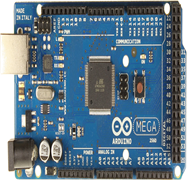
3.2. LCD
As shown in Fig. 2, a Liquid Crystal Display (LCD) screen is an electronic display module with a wide range of applications. Standard HD44780 LCDs are useful for creating standalone projects.
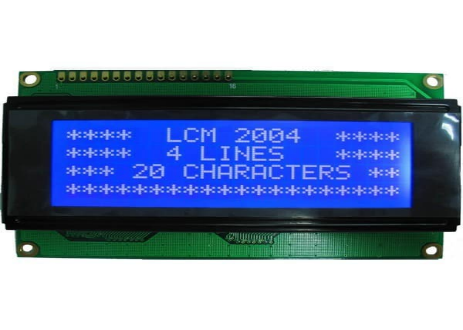
3.3. RFID
RFID supply with a signal that is 2.5 cm in diameter. If the card approaches RFID, the RFID returns an 8-digit Hexa number, as shown in Fig.3. The traveler’s personal information is hidden from view on the screen, but the card number is visible, and the number is encrypted, even when it is raised on the server, to maintain security and privacy.
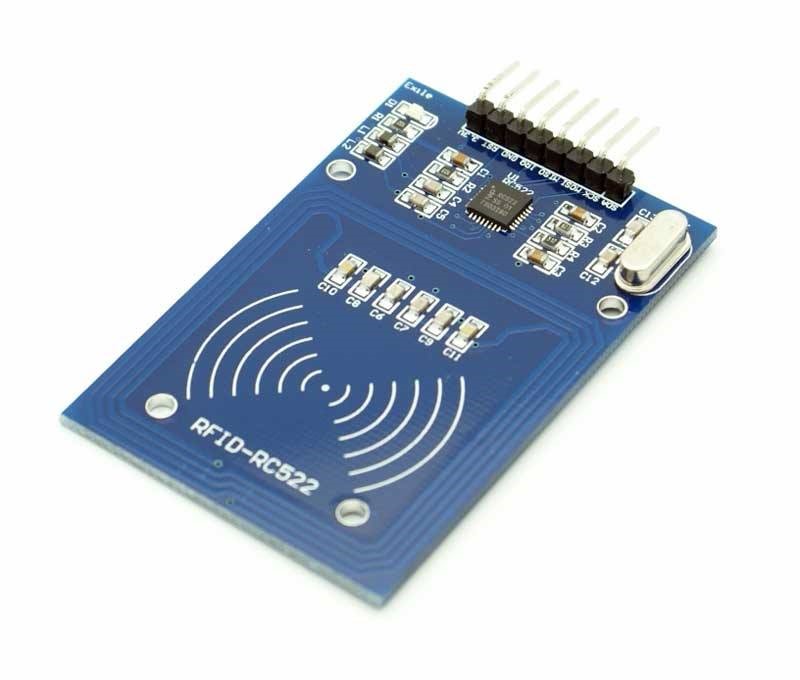
3.4. Speed Sensor:
Four pins make up a speed sensor (ground, 5 volts, analog, digital). The speed sensor has two black columns, as seen in Fig. 4. One of them is the photo diode, whose job is to send a signal to a similar column. Two LEDs make up the speed sensor. If the first LED illuminates, it shows that there is power; if it does not, it indicates that there is no power; and if the second LED illuminates, it indicates that the signal has arrived; if it does not, it means that the signal has not come. A black box, which is an amplifier that converts from digital to analog, is also included.
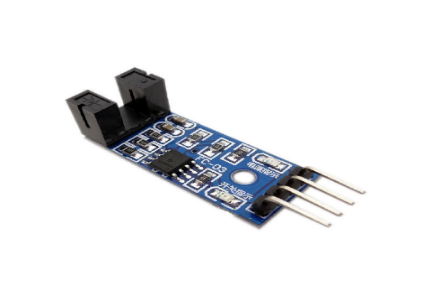
3.5. Wi-Fi
It is programmed using the Arduino ID program, which has its own unique code. It has a programmable input called micro, as shown in Fig. 5. Another option is a push button that works with a digital reset.
- D1, D2: is DIGITAL (input, output).
- A0: The only entrance to the analog.
- Vin= 5 volt where Wi-Fi is fed.
We achieved communication between the Arduino and Wi-Fi via a serial connection, as it works to transfer the D1 and D2 from Wi-Fi to TX, Rx, and we did so in the Arduino Mega on two pins (2, 3) and converted it to TX, Rx.
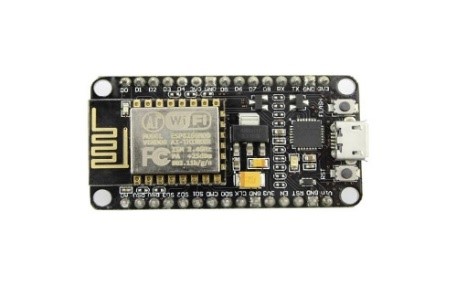
3.6. LM2596 DC-DC step-down Converter
It has two entries above positive input, negative input and below there are two entries positive output as shown in Fig. 6, negative output. Inputs enter the volt, outputs display the volt step down Converter, and we enter input and the result it displays the same input or reduce it. The range (0-35) volt.
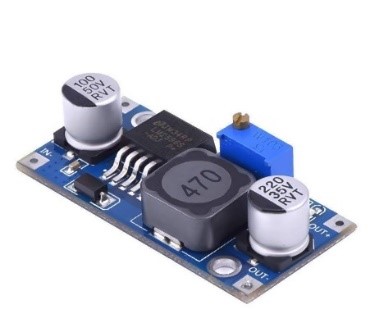
4. Result
Our system is a stand-alone system that requires no other needs for the payment process; however, some applications demand the use of a smart phone with the application within its apps in order to pay through the app, which can be costly as a prerequisite for the payment process. In addition, our system sends the remaining funds to the taxi driver office, which can complete the final accounting with the drivers. Our system does not require the interception of a code, thus it is faster than systems that do. Instead of requiring the interception of a code or having steps that take longer, our system makes the payment process directly when the card is placed near the RFID reader of our system. Our system’s complexity is also low because we use a simpler circuit than other systems. Our system’s cost can be reduced if it is mass-produced in huge quantities with cheaper component pricing and some tweaks. A card is easier to carry and handle than cash, and it makes the payment process go more smoothly. It also can’t be stolen like cash, and it eliminates the problem of losing change.
5. Conclusion
In this paper, we propose a low-cost method for taxi payment that does not require cash. The project’s key goals are to save time and effort, protect people’s money, and simplify the payment procedure. The cost of the distance traveled and the amount deducted are automatically computed by deducting the cost of the trip from the passenger’s bank account, without the passenger being stolen or defrauded. As demonstrated in Table 1, this is done at a low cost, resulting in a low-cost system. The issues that we had to deal with. To begin with, there is no memory inside the device that retains the data that has to be transferred to the server in the case that there is no online connection and the ability to upload data later when an Internet connection is available.
Second, the information on the server and confirmation of the payment process cannot be raised if there is no internet connection or if the coverage area is not covered. Finally, we will continue to build this project based on the following suggestions: Using a global positioning system (GPS) to locate the vehicle without saving the province of the taxi office on the smartphone. Providing a memory for the system to save information about the passenger card (traveled distance, price, time, date, and province where the taxi office is located on the device) in the event of the internet being disconnected and data being uploaded to the server later when the internet connection is restored. Creating a mobile application that displays the passenger’s connection fee data for each payment made.
Conflict of Interest
The authors declare no conflict of interest.
Acknowledgment
We would like to express our gratitude to all who have contributed to our research. We appreciate the anonymous reviewers’ helpful criticism and recommendations. My gratitude for my university, Palestine Technical University Kadoorei, will never be forgotten (PTUK).
Table 1: the cost of project and the price of each component.
No | Item | No | Price (one piece)($) | Total ($) |
1 | Arduino Mega 2560 with cable | 1 | 27 | 27 |
2 | Character LCD 20*4 | 1 | 14 | 14 |
3 | 22*10 DIY Prototype PCB | 1 | 5 | 5 |
4 | 40 pcs Female to Male jumper wires 20cm | 1 | 6 | 6 |
5 | RFID card inductive module KIT | 1 | 15 | 15 |
6 | 2 Pin Screw Terminal Block connector | 1 | 0.6 | 0.6 |
7 | 40 Pin Straight Male Pin Header connector | 3 | 1 | 3 |
8 | 40 Pin Single Row Female Header | 1 | 1.5 | 1.5 |
9 | LUA based ESP8266 development board NODEMCU | 1 | 24 | 24 |
10 | 6V 4.5Ah Lead Acid Battery | 1 | 11 | 11 |
11 | 5mm LED | 3 | 0.15 | 0.45 |
12 | 5V Continuous Piezo Buzzers | 1 | 0.9 | 0.9 |
13 | ON-OFF 3 Pin Latching Toggle Switch | 3 | 0.9 | 2.7 |
14 | Plastic Gear Motor with Wheel for Car | 1 | 8 | 8 |
15 | Optical Coupling Module (Speed Measuring Sensor) | 1 | 6 | 6 |
16 | Resistors | 3 | 0.15 | 0.45 |
17 | LM2596 DC-DC adjustable step-down power supply module | 1 | 7 | 7 |
18 | Potentiometer 10k ohm | 1 | 1 | 1 |
19 | Plastic encoder disc | 1 | 0.3 | 0.3 |
20 | Battery Clips | 2 | 0.15 | 0.3 |
21 | Soldering wire 1m | 10 | 0.3 | 3 |
22 | Electrical plastic box | 1 | 5.5 | 5.5 |
23 | Others | 1 | 4 | 4 |
| Total Cost= | 146.7 | ||
- M. Sadeghian, S. Dadjou, M. Meghdadi, L. Safari and S. Sadeghian, “The Design and Construction of an Intelligent Taxi Electronic Payment System Solution, ” Intelligent Control and Automation, Vol. 2 , no. 4, pp. 413-417, 2011, doi: 10.4236/ica.2011.24047.
- B.Yuan, J. Shieh, K. Li and L. Tsai, “Model of Taxi Electronic Micropayment Services, ” Journal of Global Business Management, Vol. 6, no. 1, pp. 1-14, 2010,
- D. Parkash, T. Kundu and P. Kaur, “the third technology and its applications: A review,” International Journal of Electronics, Communication & Instrumentation Engineering Research and Development (IJECIERD), Vol. 2, no. 3, pp. 109-120, 2012,
- K. Ahsan, H. Shah and P. Kingston, “ RFID Applications: An Introductory and Exploratory Study, ” International Journal of Computer Science, Vol. 7, no. 3, pp. 1-7, 2010, doi: 10.4236/ijcns.2015.85020.
- K. Jung and S. Lee, “A systematic review of RFID applications and diffusion: key areas and public policy issues,” Journal of Open Innovation: Technology, Market, and Complexity, Vol. 1, no. 9, pp. 1-19, 2015, doi: 10.1186/s40852-015-0010-z.
- S. Wamba, A. Anand and L. Carter, “RFID Applications, Issues, Methods and Theory: A Review of the AIS Basket of TOP journals,” Procedia Technology, Vol. 9, pp. 421-430, 2013, doi.org/10.1016/j.protcy.2013.12.047.
- C. Munoz-Ausecha, J. Ruiz-Rosero and G. Ramirez-Gonzalez, “RFID Applications and Security Review,” Computation , Vol. 9, no. 6 , pp. 1-21, doi.org/10.3390/computation9060069.
- E. Valero, A. Adán, and C. Cerrada, “”Evolution of RFID Applications in Construction: A Literature Review,” Sensors, Vol. 15, no. 7, pp. 15988-16008, 2015, doi: 10.3390/s150715988.
- S. Tedjini and E. Perret, “Radio-frequency identification systems and advances in tag design, ” in URSI Radio Science Bulletin, vol. 2009, no. 331, pp. 9-20, 2009, doi: 10.23919/URSIRSB.2009.7909297
- S. Ahuja and P. Potti, “An introduction to RFID technology,” Communications and Network, Vol. 2, pp. 183-186, 2010, doi : 10.4236/cn.2010.23026
- J. Pasqualeto, V. Costa and G. Silva , “ Industry 4.0 and RFID in the Automotive Sector: a Case Study on the Implementation of RFID Technology in Automaker’s Supply, ” Production and Automation Journal, Vol. 1, no. 2, pp. 78-92, 2018, https://jpaut.com.br/volume-1-number-2-2018.
- M. Schmidt and H. Ziemba, “RFID in the Automotive Industry – A Standard Based Approach towards On-Tag Data Sharing in Cross-Company Logistics, ” Lecture Notes in Informatics (LNI), Proceedings – Series of the Gesellschaft fur Informatics (GI), pp. 167-173, 2010, https://www.semanticscholar.org/paper/RFID-in-the-Automotive-Industry-A-Standard-Based-in-Schmidt-Ziemba/da45515fab6349bb683d19561e73e8b5c8d4ba5a
- H. Schalekamp, M. Mclaren, and R. Behrens, “ Exploring cashless fare collection in the context of urban public transport reform in South Africa, ” the 36th Southern African Transport Conference, CSIR International Convention Centre, Pretoria, South Africa, pp. 610-625, 2017. http://hdl.handle.net/2263/62743.
- J. Sobana et al. “A Study on Consumers Perception Regarding Cashless Transaction in Peikulam Area, ” International Journal of Business and Administration Research Review, Vol. 3, no. 21, pp. 101-108, Jan-March 2018.
- M. Kaur, M. Sandhu, N. Mohan and P. Sandhu, “RFID Technology Principles, Advantages,Limitations & Its Applications,” International Journal of Computer and Electrical Engineering, Vol. 3, no. 1, pp. 151-157, 2011. doi:10.7763/IJCEE.2011.V3.306.
- M. Yusof and M. Saman , “The Adoption and Implementation of RFID: A Literature Survey,” Library and Information Science Research E-Journal, Vol. 26, no. 1, pp. 31-52 , 2016,
DOI: 10.32655/LIBRES.2016.1.3 - I. Lacmanović, B. Radulović and D. Lacmanović, “Contactless payment systems based on RFID technology,” The 33rd International Convention MIPRO, pp. 1114-1119 , 2010.
